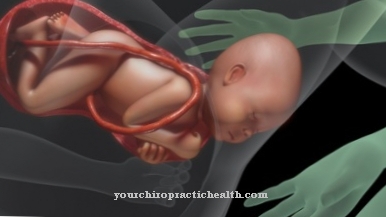The isometric contraction In contrast to dynamic, it is a static form of muscle work. It plays the decisive role in all requirements where stability is required.
What is isometric contraction?

Isometric contraction is a form of muscle work in which tension increases while the length of the muscle remains the same. There is therefore no movement in the joints involved.
The build-up of tension takes place in the smallest functional units of the muscle cells, the sarcomeres. Thousands of these elements are connected in series in each muscle cell. Incoming nerve impulses activate a certain number of sarcomeres, depending on their strength, but they never all contract at the same time. The sum of the actions results in the state of tension in the overall muscle.
The core of the sarcomeres is the actin-myosin complex. These two protein chains interact with each other during contraction. The actin filaments are connected to the boundaries of the sarcomere, called Z-stripes. The myosin lies between the actin threads and attaches itself to it with heads.
A stimulus causes the myosin heads to tip over. With concentric muscle work, this mechanism pulls the Z-strips from the actin molecules towards the center. The sarcomere and in total the entire muscle shorten. During isometric contraction, the length does not change; the tipping over only increases the tension.
Function & task
Mechanically speaking, the function of isometric contractions is to perform holding work. Joints, joint chains and whole areas of the body are stabilized and protected from unfavorable loads and damage. This form of muscle work is particularly in demand when external forces also act.
Unfavorable stresses occur due to unfavorable leverage. Various structures can be heavily stressed as a result. A typical example of this is bending and lifting that are not back-friendly. If the upper body is bent far forward because the legs are not used, a large load moment is created on the spine. The consequence is high pressure loads, especially for the intervertebral discs. The stressful moments become even more unfavorable when the back is bent. The load distribution is then even more selective. A trained straightening and good stabilization of the spine with isometric contractions of the supporting muscles can significantly reduce the load.
Often muscles with different movement functions work together in the joint stabilizing function, in which they simultaneously perform isometric muscle work. A very concise example of this is the stabilization of the knee joint when standing in a bent position, for example in the downhill squat when skiing. The knee extensors generally hold the knee in its position and prevent uncontrolled deviation. At the same time, the knee flexors act together with the ligaments as joint stabilizers by bringing the joint partners into a central position in relation to one another in order to ensure even pressure distribution.
An example of how moving and stabilizing functions complement each other is the shoulder joint. The rotator cuff is active as a stabilizer for all movements of the arm. The 4 muscles ensure that the humerus head is always in the center of the pan, regardless of the movements. Isometric contraction is an important component of this.
The fixation of a joint or part of the body by holding work is an important prerequisite for executing controlled movements. The moving parts are given a firm counter-support.
Another important function of isometric contraction is to protect internal organs. Together with fascia and fatty tissue, the tension in the muscles ensures that they are embedded in a protective cover. In the event of inflammation or irritation, the protective voltage is increased significantly in order to keep the mechanical load as low as possible.
You can find your medication here
➔ Medicines for muscle weaknessIllnesses & ailments
Isometric contraction, like other forms of contraction, can be affected by various muscular and nervous system disorders.
Nerve lesions due to damage to the spinal cord or damage to individual peripheral nerves lead to flaccid paralysis of the affected muscles. This has a particularly dramatic effect with a cross-section at the level of the cervical or upper thoracic spine. In addition to the arms and legs, the trunk can neither be moved nor stabilized. The result is usually wheelchair dependency.
Muscular dystrophies are a group of hereditary muscle diseases. In its course there is a progressive breakdown of the muscles. This affects the entire skeletal muscles as well as the muscles of the internal organs. This has consequences for isometric contractions very early on, which is particularly noticeable in the trunk stabilization. Amyotrophic lateral sclerosis has a similar effect. This is a degenerative disease of the nervous system in which only the motor part is affected.
Severe neurological diseases such as a stroke or multiple sclerosis lead to changes in muscle tone, along with other symptoms. Often a variable appearance develops, in which there are muscles with increased and decreased tension. The consequences for stability are often glaring. The torso stability is particularly affected.
The holding function of isometric muscle work is impaired in many people by a so-called muscular imbalance. Due to poor posture and behavior, certain muscles are not used enough and atrophy. This has particularly negative consequences for joint stabilization. A typical example of this is the insufficiency of the deep layers of the back muscles, which are responsible for the segmental stability of the spine. Many training programs do not address these muscles or only do so inadequately, but only deal with the large superficial systems. For this reason, even well trained people can still have back problems.




.jpg)




















.jpg)

.jpg)
